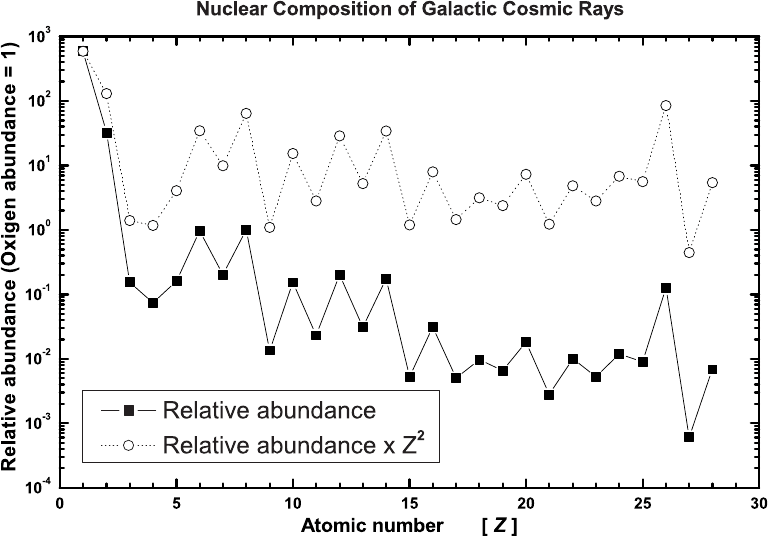Leroy C., Rancoita P.-G. Principles Of Radiation Interaction In Matter And Detection
Подождите немного. Документ загружается.


January 9, 2009 10:21 World Scientific Book - 9.75in x 6.5in ws-bo ok975x65˙n˙2nd˙Ed
330 Principles of Radiation Interaction in Matter and Detection
Panasyuk and Suslov (1996)] or, equivalently, Equation (2) in [ISO-15390 (2004)]}:
φ
s,N
(R
p
, t) = 0.37 + 3 × 10
−4
×
h
ˆ
R
s
(t − ∆t)
i
1.45
[GV], (4.61)
where R
p
is the particle rigidity (in GV) and
ˆ
R
s
(t−∆t) is a smoothed mean-monthly
average of the Wolf numbers
∗
referred to the time t−∆t (e.g., see [Nymmik (2000)]);
∆t depends on the particle rigidity, on wether a solar cycle is even or odd, and on the
solar cycle phase. ∆t expresses the time lag of GCR-flux variation relative to solar
activity (see discussion at page 315) and can be calculated using Equations (4–6)
of [ISO-15390 (2004)] {or, equivalently, Equations (10-11) in [Nymmik, Panasyuk
and Suslov (1996)]}. Outside the magnetosphere, for electrons and nuclei at 1 AU,
the modulated differential fluxes [J(1 AU, R
p
, i, t)], i.e., the differential intensities
per unit rigidity and solid angle, are obtained from:
J(1 AU, R
p
, i, t) =
C
i
β
α
i
(R
p
)
γ
i
·
R
p
R
p
− φ
s,N
(R
p
, t)
¸
∆
i
(R
p
,t)
[s m
2
sr GV]
−1
, (4.62)
where β [Eq. (4.70)] is the particle velocity divided by the speed of light; C
i
, α
i
and γ
i
are the parameters
k
of the non-modulated rigidity spectrum of the ith parti-
cle; ∆
i
(R
p
, t) {e.g., see Equation (8) of [ISO-15390 (2004)]} depends on φ
s,N
(R
p
, t)
and on the charge-number (i.e., the atomic number of the nuclide), β and rigidity
of the particle. For instance [Grandi (2008)], the measured proton-fluxes could be
compared with those expected [using Eq. (4.62)] at 1 AU as function of the pro-
ton kinetic-energy expressed in GeV for i) CAPRICE, hydrogen data [Boezio et
al. (1999)] at the top of the atmosphere (August 1994) collected when the Sun
magnetic-field lines in the northern hemisphere are directed outwards (A > 0), ii)
AMS-01 data [AMS Collab. (2000a)] at 1 AU (June 1998, A > 0) and iii) BESS,
proton data [Haino et al. (2004)] at the top of the atmosphere (August 2002) with re-
versed magnetic-field (A < 0). A few systematic departures of the computed curves
from the data were observed at low and high energies, but, in general, they do not
exceed the uncertainties of the model (e.g., see [ISO-15390 (2004)]). In addition, it
has to be remarked that, since the balloon experiments
‡
provided their data at the
top of the atmosphere, the fluxes may differ from those at 1 AU, due to the propa-
gation of particles through the magnetosphere. Note that a detailed description of
this model is beyond the purpose of the present book.
Nowadays, the modulation of CRs is often described by means of the so-called
omnidirectional distribution function
††
f(~r, ~p
p
, t) of CR particles with momentum
~p
p
, at the position
~r
and time
t
(see page 324 and, for instance, see [Fisk (1976);
∗
The Wolf number was discussed at page 306.
k
These parameters are listed, for instance, in Tables 1-2 of [ISO-15390 (2004)].
‡
The CAPRICE spectrometer was flown from 56.5
0
N and 101.0
0
W to 56.15
0
N and
117.2
0
W [Boezio et al. (1999)]; BESS-TeV spectrometer was launched from 56.5
0
N and
101.0
0
W [Haino et al. (2004)].
††
Sometimes, the omnidirectional distribution is introduced as a function of the particle rigidity
[Eq. (4.71)].

January 9, 2009 10:21 World Scientific Book - 9.75in x 6.5in ws-bo ok975x65˙n˙2nd˙Ed
Radiation Environments and Damage in Silicon Semiconductors 331
Potgieter, Le Roux, Burlaga and McDonald (1993); Potgieter (1998); Boella, Ger-
vasi, Mariani, Rancoita and Usoskin (2001); Burger and Sello (2005)] and references
therein). Furthermore, it has to be added that different authors attempted to include
a latitudinal-dependent SW speed (e.g., see [Burger and Sello (2005)]) and/or Fisk-
type heliospheric magnetic-field (see page 313) on estimating the modulation effect
(e.g., see [Burger and Hattingh (2001)]). However, even though since then more
work has been done, Parker original theory is still important because he introduced
the fundamental concepts for dealing with the propagation and modulation of the
GCRs in heliosphere (e.g., see [Jokipii (1971); Jokipii, Levy and Hubbard (1977);
Jokipii and Thomas (1981)], Chapter V of [Toptygin (1985)], Sections 6.5.3–6.5.4
of [Cravens (1997)], Chapter 13 of [Gombosi (1998)], [Burger and Hattingh (2001)],
Chapter 14 of [Schlickeiser (2002)], Section 7.7 of [Kallenrode (2004)]).
4.1.2.4 Solar, Heliospheric and Galactic Cosmic Rays in the
Interplanetary Space
The cosmic rays
¶
are particles traveling through the interstellar and interplane-
tary space. Inside the solar cavity and, mainly from the corona, the Sun is a major
source of particles and blows off a plasma [i.e., the solar wind (SW), see Sect. 4.1.2.1,
[Lang (2001); Gosling (2006)] and references therein], consisting primarily of elec-
trons and protons, but also of alpha particles (approximately 2.8–4 % [Alurkar
(1997)]) and other ions (approximately 1%), of which carbon, nitrogen, oxygen,
neon, magnesium, silicon and iron are the most abundant (e.g., Chapter 6 in [Grieder
(2001)]). The SW transports an embedded magnetic-field and is estimated to extend
up to ≈ 100 AU (Sect. 4.1.2.2) inside the galactic disk. This interplanetary magnetic-
field (e.g., see Sect. 4.1.2.1) affects the passage of charged particles [the so-called
Galactic Cosmic Rays (GCRs)] coming into the solar cavity from our galaxy
‡‡
(see,
for instance, Sect. 4.1.2.3 and [Toptygin (1985); Boella, Gervasi, Potenza, Rancoita
and Usoskin (1998); Boella, Gervasi, Mariani, Rancoita and Usoskin (2001)] and
references therein). The effect is referred to as solar modulation and depends on
the solar activity. At 1 AU in the ecliptic plane [White (1970); Encrenaz, Bibring
and Blanc (1991); Alurkar (1997)], the mean wind velocity is about (400–500) km/s
with mean proton (and electron) density of about 5 particles/cm
−3
which depends
on the solar activity (e.g., flares and sunspots).
Furthermore, some evidence has been found for particle acceleration processes,
in many cases in association with shock waves, throughout the heliosphere (e.g., see
Chapter 3 in [Schlickeiser (2002)]). Solar flares, during which a sudden release of
¶
The reader can see, for instance, Section 24 in [PDB (2008)] and, also, [Ginzburg and Syrovatskii
(1964); Gaisser (1990)], Chapter 2 of [Schlickeiser (2002)].
‡‡
The cosmic rays are considered to be originated in our galaxy, although a few of them, in parti-
cular at ultra high-energy, can have an extragalactic origin [Allard, Parizot and Olinto (2007)]. A
discussion about the local interstellar spectra, i.e., the particle spectra beyond the solar modula-
tion region can be found in [Beliaev, Nymmik, Panasyuk, Peravaya and Suslov (1996)] (see also
references therein).

January 9, 2009 10:21 World Scientific Book - 9.75in x 6.5in ws-bo ok975x65˙n˙2nd˙Ed
332 Principles of Radiation Interaction in Matter and Detection
very large amounts of energy occurs in the solar chromosphere, can also proceed
by ejecting accelerated particles into space. This variety of processes results in
generating particles like i) the Solar Energetic Particles (SEPs) with energies
∗∗
up
to > 10 MeV/nucleon, accelerated in the solar corona and lasting a few days (see
Chapter 3 in [Toptygin (1985)] and [Smart and Shea (1989); Gabriel (2000); Nymmik
(2006)]), ii) the Energetic Storm Particles (ESPs) with energies up to > 500 MeV,
accelerated in propagating interplanetary shock and lasting hours [Lario and Decker
(2001)], and iii) the Anomalous Cosmic Rays (ACRs). The solar wind and solar
energetic particles have typically low energies and are mostly prevented to reach
the Earth by the magnetosphere or are absorbed in the upper atmosphere. In [ISO-
15391 (2004)], a probabilistic model is provided for the 4–10
4
MeV SEP-event proton
fluences and p eak fluxes in the near-Earth space beyond the Earth magnetosphere
under varying solar activity
The ACRs (mostly He, N, O, Ne ions) are believed to come from interstellar neu-
tral particles, which have entered into the heliosphere, subsequently ionized by the
SW or UV radiation and finally accelerated to energies larger than 10 MeV/nucleon,
probably, at the solar wind termination shock (see [Mewaldt et al. (1993); Mewaldt
(1996); Tylka et al. (1996)] and references therein). However, collisions in the ter-
mination shock region cause some ions to reach multiply charge states [Mewaldt
(1996)] and be accelerated to even larger energies. For instance, SAMPEX has ob-
served anomalous cosmic ray oxygen ions at Earth level with energies of about
100 MeV/nucleon ([Mewaldt (1996)] and Chapter 6 in [Grieder (2001)]).
The GCRs mainly consist of protons and alpha particles (about 98%) [Simp-
son (1983); M¨uller (1989); Mewaldt (1994); ISO-15390 (2004); Stanev (2004)] (see
also Sect. 9.11.1), in addition there is a lesser amount of low-Z and medium-Z nu-
clei up to nickel, and an even lesser amount of heavier-Z nuclei
††
, where Z is the
atomic number (Sect. 3.1). At energies & 10 GeV/nucleon (e.g., see Sect. 4.1.2.3),
the solar modulation marginally affects the energy spectra which exhibit an ap-
proximate power law behavior as a function of the kinetic energy per nucleon, E
k
,
e.g., their intensities b eing ∝ E
−γ
k
, where γ is the so-called differential spectral in-
dex
∗
{see Fig. 9.37, [M¨uller (1989)], and Chapters 5 and 6 in [Grieder (2001)]}
§
. γ
is ≈ 2.74 (2.60–2.63) for hydrogen (helium) {see Table 5.1 (5.3) in Section 5.4.1
of [Stanev (2004)]}. The spectral index depends on the element, thus relative nu-
clear abundances may depend on energy: for instance, observed and calculated
abundance-ratios are shown in Figures 7 and 8 of [Engelmann et al. (1990)] for
0.8 < E
k
< 35 GeV/nucleon. Above 50 GeV/nucleon, spectral indices of elements
∗∗
The reader can find the definition of kinetic energies per nucleon in Sect. 1.4.1.
††
Parameters for the description of GCR fluxes and time dependent modulation effects using a
semi-empirical model are presented in [Nymmik, Panasyuk, Pervaja and Suslov (1992); Nymmik
and Suslov (1996); ISO-15390 (2004)] (see also the discussion at page 329).
∗
It is also referred to as spectral index.
§
In addition, the reader can refer to fluxes and energy distributions of protons, helium, carbon
and iron in [Mewaldt (1994)] (see also [Engelmann et al. (1985, 1990)]), Chapter 5 of [Stanev
(2004)] and Section 24 of [PDB (2008)] (see also [ISO-15390 (2004)]).

January 9, 2009 10:21 World Scientific Book - 9.75in x 6.5in ws-bo ok975x65˙n˙2nd˙Ed
Radiation Environments and Damage in Silicon Semiconductors 333
Fig. 4.11 From hydrogen (Z = 1) to nickel (Z = 28), relative abundances (¥) and relative abundances multiplied by Z
2
(◦) of GCRs at
16.2 GeV/nucleon normalized to oxygen (i.e., the relative abundance of oxygen is equal to 1) as a function of the atomic number Z (from [Leroy and
Rancoita (2007)]). The oxygen flux at this energy is 0.0106 ±0.0004 m
−2
s
−1
sr
−1
(GeV/nucleon)
−1
[Engelmann et al. (1990)]. The H and He relatives
abundances are averaged from [AMS Collab. (2000a,b); Sanuki et al. (2000)] (see also [AMS Collab. (2002)]). The Li (Z = 3) relative abundance is
at 5 GeV/nucleon [Mewaldt (1994)].

January 9, 2009 10:21 World Scientific Book - 9.75in x 6.5in ws-bo ok975x65˙n˙2nd˙Ed
334 Principles of Radiation Interaction in Matter and Detection
from hydrogen to iron range from 2.55 to 3.2 (e.g., see Table 3.2 in Chapter 3
of [Schlickeiser (2002)]). For energies from above several GeV to somewhat beyond
100 TeV, the overall intensity of primary nucleons [I
nucl
(E
tot,isot
)] is approximately
given by {see Equation (24.2) in [PDB (2008)]}:
I
nucl
(E
tot,isot
) ≈ 1.8 × 10
4
I
isot
µ
E
tot,isot
1 GeV
¶
−γ
p
[m
2
s sr GeV/nucleon]
−1
, (4.63)
where E
tot,isot
= E
tot
isot
/I
isot
in GeV/nucleon is the energy-per-nucleon
¶
[including
the rest-mass energy, see Eq. (4.66)] of an isotope with I
isot
nucleons and, finally,
γ
p
≈ 2.7 is the differential spectral index of the CR flux. In Fig. 4.11, the rela-
tive abundances of GCRs up to nickel (Z = 28) are shown at 16.2 GeV/nucleon
‡
,
normalized to oxygen (i.e., the oxygen relative abundance is equal to 1), as a func-
tion of the atomic number Z. The oxygen flux, at this energy, is 0.0106 ± 0.0004
m
−2
s
−1
sr
−1
(GeV/nucleon)
−1
[Engelmann et al. (1990)]. The H and He relatives
abundances are averaged from [AMS Collab. (2000a,b); Sanuki et al. (2000)] (see
also [AMS Collab. (2002)]). Since in matter, at sufficiently high-energies (see
Sect. 2.1.4) the collision energy-loss depends on Z
2
[Eq. (2.1)], in the same figure
the relative abundances are also shown multiplied by Z
2
(e.g., see [Mewaldt (1994);
Codegoni et al. (2004b); Consolandi, D’Angelo, Fallica, Mangoni, Modica, Pensotti
and Rancoita (2006)]). In the cosmic radiation, electrons and positrons are less than
about 1 % of the proton flux at about 10 GeV (e.g., see [M¨uller (1989); Barwick et al.
(1998); AMS Collab. (2000c)] and references therein). In the 5.0 to 50 GeV energy
range, the positron and electron differential spectral indexes are about 3.31 and
3.09, respectively [Barwick et al. (1998)]. Above 1 GeV, the positrons are less than
10 % of the combined electron–positron flux [M¨uller (1989); Barwick et al. (1998)],
but above 5–10 GeV their fraction has been observed to increase ([M¨uller (1989);
Aharonian and Atoyan (1991); Barwick et al. (1998)] and Chapter 2 of [Schlickeiser
(2002)]).
The GCRs are a major radiation concern for missions with long duration outside
the Earth magnetosphere. In addition, since they have energies large enough, most
of them pass through the magnetosphere and are observed at LEOs.
The flux of GCR’s is a possible hazard to spacecraft electronics, because GCR’s
can penetrate shielding materials [Barth (1997)]. In fact after a standard aluminum
shield of 100 mils, fast energetic charged particles
∗∗
will be able to inflict radiation
damages. Each isotopic element of these penetrating charged particles releases a
dose and loses an amount of energy by the NIEL process
‡‡
, which are non-negligible
fractions of those due to the proton component. As a consequence, even for not
heavy-shielded VLSI components, the proton component is expected to contribute
¶
At high energies per nucleon, we have E
k
≈ E
tot,isot
.
‡
The Li, Z = 3, relative abundance is at 5 GeV/nucleon [Mewaldt (1994)].
∗∗
These are, for instance, electrons, protons, alpha-particles and iron ions above about 1.2 MeV,
22.5 MeV, 22.5 MeV/nucleon and 90 MeV/nucleon, respectively.
‡‡
The reader can see Sect. 4.2.1, [Colder et al. (2002); Codegoni et al. (2004b); Consolandi,
D’Angelo, Fallica, Mangoni, Modica, Pensotti and Rancoita (2006)] and references therein.

January 9, 2009 10:21 World Scientific Book - 9.75in x 6.5in ws-bo ok975x65˙n˙2nd˙Ed
Radiation Environments and Damage in Silicon Semiconductors 335
Table 4.1 Dependence (from [Leroy and Rancoita
(2007)]) of the dose rate (Sv/day), due to protons
from the inner radiation belt, on the altitude and
inclination of the orbit {e.g., see [Miroshnichenko
(2003)] and references therein}.
Orbit altitude
km 0
◦
45
◦
90
◦
300 0.05 0.05 0.05
500 0.16 0.16 0.16
2500–3000 110.00 26.00 18.00
7500 2.60 3.40 2.40
with an important, but not dominant, fraction of both the dose and the NIEL
deposition.
Furthermore, after intro ducing the radiation weighting factor to account for
the biological effectiveness, heavier elements like Fe, Si, Mg and O make an even
larger contribution to the dose equivalent. Moreover, it has been estimated that,
for ≈ 3 g/cm
3
Al shielding, about 75 % of the dose equivalent is due to GCRs
with kinetic energies lower than 1 GeV/nucleon ([Mewaldt (1994)] and reference
[13] therein). Lockwood and Hapgood (2007) pointed out that, i) while in Earth’s
biosphere we typically receive 2 mSv per year from cosmic radiation, ii) the effective
GCR doses in interplanetary space are greater than in the biosphere by factors of
about 90 and 250 at sunspot maximum and minimum, respectively, and that iii)
even in the most favorable time, a manned trip to Mars would let the crew to receive
up to the lifetime radiation allowance for men and more than the double for women.
4.1.2.5 Trapped Particles and Earth Magnetosphere
The magnetosphere (see Sect. 4.1.2.2) is the volume of space where the Earth’s
magnetic-field extends its effects [Knecht and Shuman (1985); Kivelson and Bagenal
(2006); Schulz (2007)]. Close to the Earth, the magnetic field is approximately
represented by a dipole, slightly offset from the center of the Earth and inclined
by about 11.3
◦
from the axis of rotation. Its magnetic dipole axis intersects the
Earth’s surface in two points, the boreal (northern) pole at 78.3
◦
N 69
◦
W and
austral (southern) pole at 78.3
◦
S 111
◦
E. The SW compresses the magnetosphere
side toward the Sun to a distance of (6–10) Earth radii (one Earth radius, Re, is
about 6371 km) as a function of the solar activity and stretches the opposite side
into a tail (the so-called magnetotail) to perhaps 1000 Re (Fig. 4.8). The Earth’s
radiation belts in the inner magnetosphere
∗
, one of the first major discoveries of
the satellite age [Van Allen, Ludwig and McIlwain (1958); Hess (1968)], are due
∗
For a general description, one can see, for instance, [Spjeldvik and Rothwell (1985)].

January 9, 2009 10:21 World Scientific Book - 9.75in x 6.5in ws-bo ok975x65˙n˙2nd˙Ed
336 Principles of Radiation Interaction in Matter and Detection
to the structure of the magnetic-field lines near the Earth and consist of trapped
particles that gyrate around geomagnetic-field lines, travel back and forth along
geomagnetic-field lines between conjugate points in opposite hemispheres, and drift
around the Earth.
The overall particle flux is due to a combination of Primary Cosmic Rays
‡‡
(PCRs), trapped ACRs, trapped solar-wind particles, soft and energetic Secon-
dary Cosmic Rays (SCRs), mainly consisting of electrons and protons [Buenerd et
al. (2000)] generated by the interactions of PCRs with the atmosphere (e.g., see
Section 12 in [Leroy and Rancoita (2000)], Chapter 1 in [Grieder (2001)], [Stanev
(2004)], Chapters 6 and 7 in [Grupen (2005)] and references therein). Nevertheless,
the Earth magnetosphere prevents the arrival of less energetic cosmic and solar
rays. The value of the rigidity, below which the PCRs cannot reach an observation
position, is called local rigidity of geomagnetic cut-off
‡
, R
p
cut
(see, for instance, [Sto-
ermer (1930); Fermi (1950); Shea, Smart and McCracken (1965)] and Section 6.2.3.1
in [Knecht and Shuman (1985)]). The transport of the PCRs, from the Earth mag-
netosphere boundary at 1 AU through the magnetosphere to the atmosphere, is
described by the so-called transmission function (TF), which depends on the PCR
rigidity, location of the observation point, solid angle and pointing of the detecting
instrument (e.g., see [Bobik et al. (2006)] and references therein). The TF becomes
0, when the incoming PCRs cannot reach the observation location any more, thus
the particle rigidity is lower than R
p
cut
.
Inside the Earth magnetosphere there are two Van Allen belt regions (e.g., see
[Hess (1968)]) of trapped fast particles (mostly electrons and protons). In between
the two regions, there is the so-called slot region. The inner radiation belt, discovered
by Van Allen [Van Allen, Ludwig and McIlwain (1958)], is relatively compact. In
the region above the equator, it extends perhaps up to about 2.4 Re and is centered
at about 1.5 Re. It is populated by protons with energies in the (10–100) MeV range
and a density of about 15 protons per m
3
[Lang (2001)]. There are also electrons
of lower energies, but exceeding 0.5 MeV. The population is fairly stable, but is
subject to occasional perturbations due to geomagnetic storms, and varies along a
11 year solar cycle (e.g., see Sect. 4.1.2.1). The main sources of particles are so-
lar energetic particles and interactions of cosmic ray in the atmosphere (e.g., see
[Hess (1968)]). In the inner radiation belt many satellites, designed to provide tele-
phony (whether for mobile or fixed phones) and internet services for a broad range
of users, move on LEOs where they encounter trapped energetic charged parti-
cles. These ones represent an hazard primarily for astronauts and also for VLSI
electronics. The doses change considerably at small altitudes and depend on the
inclination of the orbit plane. For instance, the dose rate for protons of the inner
radiation belt is shown in Table 4.1 (e.g., see Sect. 1.1 of [Miroshnichenko (2003)]
‡‡
Above about 100 MeV/nucleon, the PCRs are mostly GCRs.
‡
For a practical introduction to the cut-off rigidity of cosmic rays, the reader can see Chap-
ter 1 in [Grieder (2001)]. For practical calculations, the reader can refer to the web sites:
http://hpamsmi2.mib.infn.it/∼wwwams/rig.html and/or http://pfunc.selfip.biz/riho/index.html.

January 9, 2009 10:21 World Scientific Book - 9.75in x 6.5in ws-bo ok975x65˙n˙2nd˙Ed
Radiation Environments and Damage in Silicon Semiconductors 337
and references therein). These dose rates take into account the radiation weighting
factor for protons
†
, but can be adapted to provide rate estimates in other absorbers
(e.g., in silicon).
Further out, centered at about (4.5–5.0) Re, the outer radiation belt mainly
contains electrons with energies up to 10 MeV. This belt is mostly generated by
the injection of particles following geomagnetic storms, which make it much more
dynamic than the inner belt (it is also subject to day-night variations). It has an
equatorial distance of about (2.8–12) Re, with a maximum for electrons above 1 MeV
occurring at about 4 Re. Unlike the inner belt, this population fluctuates widely,
rising when magnetic storms inject fresh particles from the tail of the magneto-
sphere, then gradually falling off again. The outer radiation belt coincides with the
geostationary orbit of many communications satellites.
A feature of the Van Allen belts is the so-called South Atlantic Anomaly (SAA):
the offset of the geomagnetic dipole axis towards the northwest Pacific causes an
anomalously weak geomagnetic-field strength in a region which, for an altitude of
about 500 km (i.e. at LEO), extends at latitudes between about -55
◦
–0
◦
and longi-
tudes between about -80
◦
–20
◦
[Barth (1997)]. In this region, trapped radiation par-
ticles can reach lower altitude before bouncing back to the northern hemisphere. The
orbit parameters of a spacecraft (inclination and altitude) determine the number of
passes made per day through this region. At an orbit below an altitude of about
(500–550) km a considerable part of absorbed radiation dose is caused by passing
the SAA.
A few years ago, the analysis of SAMPEX data
§
has confirmed the existence of
belts containing trapped ACRs, i.e., heavier nuclei (like N, O and Ne) with energies
of the order of 10 MeV/nucleon, already observed by COSMOS satellites [Grigorov
et al. (1991)]. These trapped particles have steep energy spectra and are unlikely
to be a significant radiation hazard for (lightly-) shielded systems, i.e., with about
50 mils Al equivalent (see for instance [Tylka et al. (1996)]).
PCRs are particles reaching the Earth from the outer space. However the flux
of PCRs is only a tiny fraction of the total particle flux observed at the Earth’s
surface or at LEOs, since a large amount of SCRs can be generated by the intera-
ctions of the PCRs with the upper and middle atmosphere. Part of the SCRs can
remain trapped by the magnetic field near the Earth. Their flux depends on the flux
and energy spectrum of the PCRs and, consequently, on the solar modulation (see
Sect. 4.1.2.4). Thus, the observed flux of SCRs is also related to phenomena like the
solar activity and magnetic storms. Trapped energetic SCRs are always present and
populate a radiation belt at low altitude. The existence of trapped and quasi-trapped
high-energy (up to few GeV/c’s) particles
‡
, generating the so-called AMS Radiation
†
For instance, the radiation weighting factor for protons is 2 (Table 29.1 of [PDB (2008)]). The
biological effects of radiation are treated, for instance, in [Stather and Smith (2005)].
§
One can see, e.g., [Cook et al. (1993); Cummings et al. (1993); Selesnick et al. (1995); Mewaldt,
Selesnick and Cummings (1997)].
‡
These particles are mostly protons, electrons and positrons.

January 9, 2009 10:21 World Scientific Book - 9.75in x 6.5in ws-bo ok975x65˙n˙2nd˙Ed
338 Principles of Radiation Interaction in Matter and Detection
belt located at LEO, was observed by the AMS mission (Space Shuttle flight STS-91,
June 1998, see [AMS Collab. (2000a,b,d, 2002)] and references therein). As already
mentioned, while the PCRs come from outside the magnetosphere, the SCRs are
originated in the Earth atmosphere. They could be distinguished by reconstructing
their trajectories
∗
from the observation point, i.e., the AMS spectrometer, back to
the border of the magnetosphere (e.g., PCRs) or to the border of the atmosphere
(e.g., SCRs).
Let us indicate by E
tot
k
the total kinetic-energy of an isotope with I
isot
nucleons
[i.e., with mass number I
isot
, Eq. (3.1)] and rest mass m
isot
m
isot
∼ I
isot
m
nucl
where m
nucl
is the nucleon mass (see page 219). The kinetic energy per nucleon,
E
k
, is
E
k
=
E
tot
k
I
isot
. (4.64)
From Eq (1.15), the isotope momentum, p
isot
, is
p
isot
=
q
(E
tot
k
+ m
isot
c
2
)
2
− m
2
isot
c
4
c
. (4.65)
In addition [see Eq. (1.12)], the isotope total-energy is
E
tot
isot
= E
tot
k
+ m
isot
c
2
. (4.66)
Moreover under the assumption that the direction of momentum is perpendicular
to the direction of the magnetic field, the momentum p
isot
and magnetic rigidity
R
isot
of the isotope of nuclear charge Ze (e is the electron charge) can be expressed
as a function of the kinetic energy per nucleon by
R
isot
=
p
isot
Ze
,
=
q
(E
tot
k
+ m
isot
c
2
)
2
− m
2
isot
c
4
Zec
, (4.67)
from which we get:
R
isot
=
q
(I
isot
E
k
+ I
isot
m
nucl
c
2
)
2
− (I
isot
m
nucl
)
2
c
4
Zec
=
µ
I
isot
Z
¶
q
(E
k
+ m
nucl
c
2
)
2
− m
nucl
2
c
4
ec
=
µ
I
isot
Z
¶
p
E
k
(E
k
+ 2m
nucl
c
2
)
ec
. (4.68)
∗
On this subject, the reader can see, for instance, [Bobik et al. (2000, 2001, 2005)] and references
therein.

January 9, 2009 10:21 World Scientific Book - 9.75in x 6.5in ws-bo ok975x65˙n˙2nd˙Ed
Radiation Environments and Damage in Silicon Semiconductors 339
Conversely, by squaring the two sides of Eq. (4.67), we obtain
R
2
isot
Z
2
e
2
c
2
+ m
2
isot
c
4
=
¡
E
tot
k
+ m
isot
c
2
¢
2
,
and, finally,
E
k
=
1
I
isot
µ
q
R
2
isot
Z
2
e
2
c
2
+ m
2
isot
c
4
− m
isot
c
2
¶
= c
2
−m
nucl
+
s
R
2
isot
µ
Z
I
isot
¶
2
³
e
c
´
2
+ m
nucl
2
. (4.69)
It has to be noted that, using Eqs. (1.6–1.10), from Eqs. (4.65–4.67) we can derive
β
isot
=
p
isot
c
E
tot
isot
=
R
isot
Zec
p
(R
isot
Zec)
2
+ m
2
isot
c
4
=
R
isot
q
R
2
isot
+ [(m
isot
c)/(Ze)]
2
. (4.70)
Nowadays, it is common to use the quantity (referred to as particle rigidity)
R
p
isot
≡
p
isot
c
Ze
(4.71)
in units of GV, where p
isot
is the isotope momentum in GeV/c. Equa-
tions (4.68, 4.69) can be rewritten, without any assumption on the momentum
and magnetic-field directions, as:
R
p
isot
=
µ
I
isot
Z
¶
p
E
k
(E
k
+ 2m
nucl
c
2
)
e
, (4.72)
and
E
k
= c
2
−m
nucl
+
s
µ
Z
I
isot
¶
2
µ
R
p
isot
e
c
2
¶
2
+ m
nucl
2
, (4.73)
respectively. Equation (4.70) can be rewritten as
β
isot
=
R
p
isot
q
(R
p
isot
)
2
+ [(m
isot
c
2
)/(Ze)]
2
. (4.74)
From Eqs. (1.15, 4.71), the rigidity of a proton with kinetic energy E
k,p
is
R
p
H
=
p
E
k,p
(E
k,p
+ 2m
p
c
2
)
e
, (4.75)
where m
p
is the rest mass of the proton. Since m
p
≈ m
nucl
(Sect. 3.1), from an
inspection of Eqs. (4.72, 4.75) the rigidity of an isotope heavier than proton with
kinetic energy per nucleon E
k
is
R
p
isot
≈
µ
I
isot
Z
¶
R
p
H
, (4.76)
